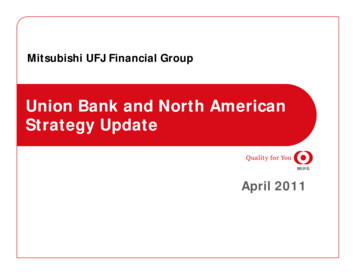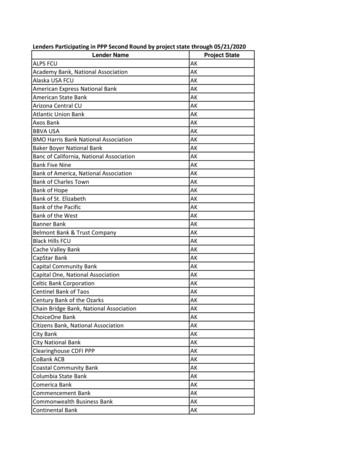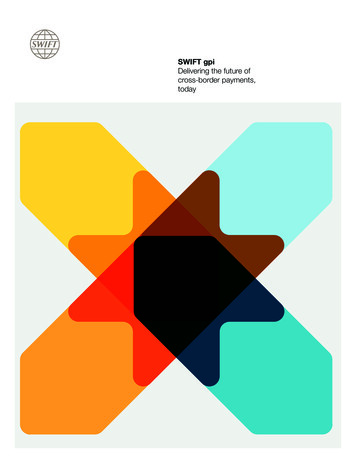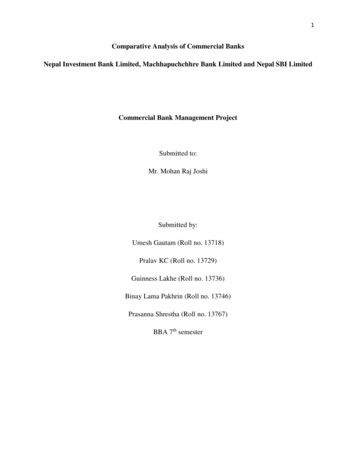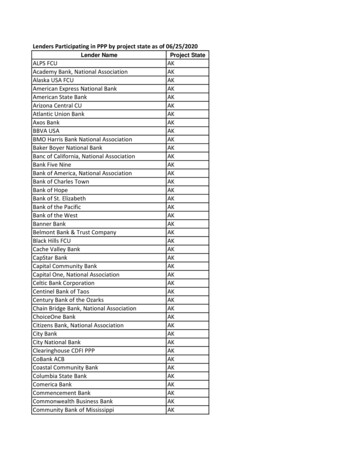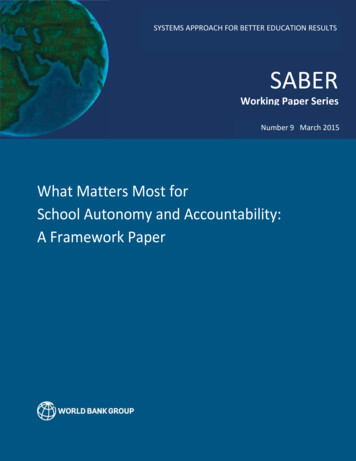
Transcription
SYSTEMS APPROACH FOR BETTER EDUCATION RESULTS SABERWorking Paper SeriesNumber 9 March 2015What Matters Most forSchool Autonomy and Accountability: A Framework Paper
Systems Approach for Better Education Results SABER Working Paper Series What Matters Most for School Autonomy and Accountability: A Framework Paper Angela Demas and Gustavo Arcia Global Engagement and Knowledge Team Education Global Practice The World Bank March 30, 2015
Table of Contents Acronyms . i Acknowledgements .ii Abstract . iii I. Introduction . 1 Objectives . 1 Decentralization and Education . 1 II. What are School Autonomy and School Accountability? . 2 III. Conceptual Framework . 4 Evidence . 8 The Three A’s and SABER SAA . 13 IV. What Matters Most? SAA Policy Goals, Policy Actions and Evidence . 13 Policy Goal One: Level of Autonomy in the Planning and Management of the School Budget . 14 Policy Goal Two: Level of Autonomy in Personnel Management . 18 Policy Goal Three: Role of the School Council on School Governance . 22 Policy Goal Four: School and Student Assessment . 27 Policy Goal Five: School Accountability . 30 V. Implementing the SABER Framework . 34 SABER Instrument and Methodology . 34 VI. Conclusions . 36 References . 37 What Matters Most For School Autonomy and Accountability: A Framework Paper i
Appendix 1: School Autonomy and Accountability Policy Goals and Policy Actions . 45 Appendix 2: Rubric for SABER School Autonomy and Accountability . 46 Figure 1. The Short and Long Routes to Accountability . 5 Figure 2. The 3 A’s Model as a ClosedͲloop System . 7 Figure 3. SBM implementation Ͳ years until full impact of intervention . 11 Box 1. What are School Autonomy and Accountability? . 3 Box 2. Paths to SchoolͲBased Management . 6 Box 3. ClosedͲloop systems and SBM . 6 Box 4. Managerial Activities . 7 Table 1. Selected experiences with SBM interventions and their impacts . 9 Table 2. Policy Goal 1: Policy actions, indicators and evidence . 18 Table 3. Policy Goal 2: Policy actions, indicators and evidence . 21 Table 4. Policy Goal 3: Policy actions, indicators and evidence . 26 Table 5. Policy Goal 4: Policy actions, indicators and evidence . 30 Table 6: Policy Goal 5: Policy actions, indicators, and evidence . 33 What Matters Most For School Autonomy and Accountability: A Framework Paper ii
Acronyms AAA BOS CMS DCI EDUCO EMIS ETP OECD PEC PACEͲA PISA SAA SIPs SBM SABER Autonomy, Assessment, and Accountability Bantuan Operasional Sekolah CommunityͲManaged Schools Data Collection Instrument Educación con Participación de la Communidad Education Management Information System Extra Teacher Program Organisation for Economic CoͲoperation and Development Programa Escuelas de Calidad Partnership for Advancing CommunityͲbased EducationͲAfghanistan Program for International Student Assessment School Autonomy and Accountability School Improvement Plans SchoolͲBased Management Systems Approach for Better Education Results What Matters Most For School Autonomy and Accountability: A Framework Paper i
Acknowledgements This report was prepared by Angela Demas, Senior Education Specialist and Task Team Leader, Global Engagement and Knowledge Team; and Gustavo Arcia, Consultant, Global Engagement and Knowledge Team. Thanks in particular go to the meeting chairs: Amit Dar, Director, Education, and Harry Patrinos, Practice Manager, for their guidance and feedback on the content and direction of the paper. We would like to thank the peer reviewers: Dandan Chen, Program Leader (ECCU3) and Tazeen Fasih, Senior Education Specialist (GEDDR), whose valuable feedback provided insights and helped to enhance the quality of the paper. The report also benefitted from the advice and inputs from Luis Benveniste, Practice Manager; Husein AbdulͲHamid, Donald Rey Baum, Mary Breeding, Marguerite Clarke, Emily Garner, Oni LuskͲStover, Clark Matthews, Halsey Rogers, and Takako Yuki. We are also grateful to the prior members of the SABER SAA team, particularly Kazuro Shibuya, Senior Education Specialist (seconded from JICA) who contributed to the piloting of initial instruments, the revision of the policy actions, a set of rubrics and the data collection instrument based on this framework paper. In addition, we would like to thank Restituto Jr. Cardenas, Program Assistant and Fahma Nur, Senior Program Assistant for their support in formatting and finalizing the paper. What Matters Most For School Autonomy and Accountability: A Framework Paper ii
Abstract This paper provides an overview of what matters most for school autonomy and accountability. The focus is on public schools at the primary and the secondary level. This paper begins by grounding School Autonomy and Accountability in its theoretical evidence base (impact evaluations, lessons learned from experience, and literature reviews) and then discusses guiding principles and tools for analyzing country policy choices. The goal of this paper is to provide a framework for classifying and analyzing education systems around the world according to the following five policy goals that are critical for enabling effective school autonomy and accountability: (1) level of autonomy in the planning and management of the school budget; (2) level of autonomy in personnel management; (3) role of school councils in school governance; (4) school and student assessment, and (5) accountability to stakeholders. This paper also discusses how country context matters to school autonomy and accountability and how balancing policy goals matters to policy making for improved education quality and learning for all. What Matters Most For School Autonomy and Accountability: A Framework Paper iii
I.Introduction Objectives The objective of this paper is to provide a framework for what matters most in fostering school autonomy and accountability (SAA) and why this is important. The focus is on public schools at the primary and secondary levels. The paper also discusses School Autonomy and Accountability tools for assessing a country’s development of policies that provide an enabling environment for SAA. SABERͲSAA is one of the instruments that has been developed and tested under SABER, the Systems Approach to Better Education Results, initiative created by the World Bank as part of its education strategy (World Bank 2011b). The application of the policy intent and policy implementation instruments can be important tools for education system reform if they are used as instruments for planning and monitoring the enabling conditions for improving system performance. This paper begins by providing a short background on decentralization and its relationship to the education sector through SAA. It then provides the case for school autonomy and accountability and introduces the conceptual framework for SAA. Next, it grounds SAA in its theoretical evidence base and discusses the guiding principles and tools for analyzing country policy choices. A goal of the paper is to provide a framework for classifying and analyzing education systems around the world according to the following five policy goals that are critical for enabling effective school autonomy and accountability: (1) level of autonomy in the planning and management of the school budget; (2) level of autonomy in personnel management; (3) role of school councils in school governance; (4) school and student assessment, and (5) accountability to stakeholders. This paper also discusses how country context matters to school autonomy and accountability and how balancing policy goals matters to policy making for improved education quality and learning for all. Decentralization and Education In matters of governance, decentralization is seen as an appealing alternative to the centralized state given the range of benefits associated with this approach. It is regarded as a way to: (i) introduce more intergovernmental competition and checks and balances; (ii) make government more responsive and efficient in service delivery, (iii) diffuse social and political tensions and ensure local and political autonomy (Bardhan 2002). Decentralization can help ease decisionͲmaking bottlenecks that are caused by central government planning and control of important economic and social activities. It can also help simplify complex bureaucratic procedures and increase sensitivity to local conditions and needs, by placing more control at the local level where needs are best known. With decentralization, the impact will depend on the many factors related to design. Similar to other policy issues that are complicated, the outcome will depend on a myriad of individual political, fiscal, and administrative policies and institutions as well as their interaction within a given country (Litvak and Seddon 1999; Bardhan 2002). At the same time, it is important to keep in mind that structures of local accountability may not be in place in developing countries and “capture” by local elites may frustrate the goal of quality and equitable public service delivery. To be effective, decentralization must attempt to change existing structures of power within communities, improve opportunities for participation and voice, and engage all citizens including the poor or disadvantaged in the process (Bardhan 2002). There seems to be a consensus since the 1980s, that too much centralization or, conversely, absolute local autonomy are both harmful and that it is necessary to put in place a better system of collaboration between the national, regional and local centers of decisionͲmaking. For decentralizing education What Matters Most For School Autonomy and Accountability: A Framework Paper 1
systems, the process requires strong political commitment and leadership in order to succeed (McLean and King 1999). Countries around the world have been experimenting with some form of education decentralization. It has become central to education policy. Initial evidence indicates that decentralization to subnational governments may be insufficient, and in order to improve schools and learning, increased autonomy for communities and school actors may be necessary (McLean and King 1999). A way to decentralize decisionͲmaking power in education from the central government to the school level is known as schoolͲbased management (SBM) (Caldwell 2005; Barrera, Fasih and Patrinos 2009). Decentralized education can help get parents and students closer to the providers of education, ensuring better access to pedagogical and managerial methods more in tune with their needs. However, if such an approach is taken to the limit, it may result in a fragmented education system where standards may be reduced and local community values may become too parochial to benefit society at large (Ritzen, van Domelen and de Vijlder 1997). This paper discusses what matters most for school autonomy and accountability and producing an enabling environment for the intended outcomes. II.What are School Autonomy and School Accountability? Improved school management leads to better outcomes. Decentralization, school autonomy and community empowerment have been at the center of the education policy discussions for several decades. We are beginning to understand more and more through a growing body of evidence that higher management quality is strongly associated with better educational outcomes (Bloom et al. 2014). It leads to more efficient schools that have autonomy to make decisions on budget, management, personnel, and everyday items that have an impact on their school environment and learning that is taking place. This includes changing the environment in which decisions about resource allocation are made, where effective schoolͲlevel decisionͲmaking can take place by schoolͲlevel agents. It also means that those who are taking decisions are accountable to higher levels of authority at the district and central levels but also to the greater school community who all, to some degree, have oversight roles whether they are policyͲmakers, supervisors or consumers of education services. School autonomy and accountability are key components of an education system that ensure educational quality. By transferring core managerial responsibilities to schools, school autonomy fosters local accountability; helps reflect local priorities, values, and needs through increased participation of parents and the community; and gives teachers the opportunity to establish a personal commitment to students and their parents. Increased school autonomy and improved accountability are necessary conditions for improved learning because they align teacher and parent incentives (Bruns, Filmer and Patrinos 2011). Studies have shown a clear causal link between school autonomy and efficiency in resource use (Barrera et al. 2009). Viewed in this context, school autonomy and accountability should be considered essential components of an overall strategy for improving learning outcomes. Benchmarking and monitoring indicators of school autonomy and accountability allows a country to rapidly assess its education system, thus setting the stage for improving policy planning and implementation. To be clear on what is meant by school autonomy and accountability in this paper see definitions in Box 1. What Matters Most For School Autonomy and Accountability: A Framework Paper 2
Box 1. What are School Autonomy and Accountability? School autonomy is a form of school management in which schools are given decisionͲmaking authority over their operations, including the hiring and firing of personnel, and the assessment of teachers and pedagogical practices. School management under autonomy may give an important role to the School Council, representing the interests of parents, in budget planning and approval, as well as a voice/vote in personnel decisions. By including the School Council in school management, school autonomy fosters accountability (Di Gropello 2004, 2006; Barrera, Fasih and Patrinos 2009). In its basic form accountability is defined as the acceptance of responsibility and being answerable for one’s actions. In school management, accountability may take other additional meanings: (i) the act of compliance with the rules and regulations of school governance; (ii) reporting to those with oversight authority over the school; and (iii) linking rewards and sanctions to expected results (Heim 1996; Rechebei 2010). To be effective, school autonomy must function on the basis of compatible incentives, taking into account national education policies including incentives for the implementation of those policies. Having more managerial responsibilities at the school level automatically implies that a school must also be accountable to local stakeholders as well as national and local authorities. The empirical evidence from education systems in which schools enjoy managerial autonomy is that autonomy is beneficial for restoring the social contract between parents and schools and instrumental in setting in motion policies to improve student learning. The progression in school autonomy in the last two decades has led to the conceptualization of SchoolͲBased Management (SBM) as a form of a decentralized education system in which school personnel are in charge of making most managerial decisions, frequently in partnership with parents and the community often through school councils1 (Barrera, Fasih, and Patrinos 2009). More local control helps create better conditions for improving student learning in a sustainable way since it gives teachers and parents more opportunities to develop common goals, increase their mutual commitment to student learning, and promote more efficient use of scarce school resources. Types of SchoolͲBased Management. In addition to the degree of devolved autonomy provided to the school level, SBM must define who is invested with the decisionͲmaking power at the school level. There are four SBM models to help us define this (BarreraͲOsorio et al. 2009): x Administrative control: Authority is devolved to the principal. Its aim is to make each school more accountable to the central district. The benefits include increasing efficiency of expenditures on personnel and curriculum and making one person more accountable to the central authority. x Professional control: Teachers hold the main decisionͲmaking authority. This model aims to make better use of teachers’ knowledge of what the school needs at the classroom level. It can motivate teachers and lead to greater efficiency and effectiveness in teaching. x CommunityͲcontrol: Parents or the community have major decisionͲmaking authority. Under this model it is assumed that principals and teachers become more responsive to parents’ needs and the curriculum can reflect local needs. 1 The term “school council” is synonymous with several other terms used around the world, such as school management committee, parent council, school committee, etc. For consistency, this paper will use school council. What Matters Most For School Autonomy and Accountability: A Framework Paper 3
xBalanced control: DecisionͲmaking authority is shared by the principal, teachers and parents. The aims are to take advantage of teachers’ knowledge of the school to improve school management and to make schools more accountable to parents. Existing models of SBM in real life generally blend the four models. SBM is not a set of predetermined policies and procedures, but a continuum of activities and policies put into place over time and with contextual sensitivity to improve the functioning of schools, allowing parents and teachers to focus on improvements in learning. While there is little hard evidence that teacher quality grows as a direct result of SBM, it can be argued that increasing school accountability is a necessary condition for improving teacher quality. Implementing SBM can augment the support that school councils and parents provide to good teachers through various methods including salary and nonͲsalary incentives and establishing the necessary conditions to attract the best teachers (Arcia et al. 2011). As such, SBM can foster a new social contract between teachers and the community in which local cooperation and local accountability drive improvements in professional and personal performance by teachers (Patrinos 2010). III.Conceptual Framework While there have been many schools of thought across the different experiences in school autonomy, the principle of accountability was not initially linked with school autonomy (Eurydice 2007). In the midͲ1990s, the concept of autonomy with accountability became increasingly important and assumed different forms in different countries. PISA results suggest that when autonomy and accountability are combined, they tend to be associated with better student performance (OECD 2011). The experience of highͲperforming countries2 on PISA indicates that: xEducation systems in which schools have more autonomy over teaching content and student assessment tend to perform better. xEducation systems in which schools have more autonomy over resource allocation and that publish test results perform better than schools with less autonomy. xEducation systems with standardized student assessment tend to do better than those without such assessments. It was not until almost 10 years after the concept of linking autonomy with accountability started to emerge that that The World Development Report 2004 “Making service work for poor people” introduced a conceptual framework for the empowerment of communities. The report highlights the significance of a “short” route of accountability that runs directly from users (e.g. citizens/clients/ communities) to frontline service providers (e.g. schools), in addition to an indirect or “long” route of accountability where users hold service providers accountable through the state (Figure 1). SchoolͲbased management has been referred to as an effective way to achieve the short route of accountability in the education sector. 2 Examples of high performing countries that have implemented schoolͲbased management policies and frameworks include the Netherlands, Canada, and New Zealand among others. What Matters Most For School Autonomy and Accountability: A Framework Paper 4
Figure 1. The Short and Long Routes to Accountability Source: Adapted from WDR 2004 This framework illustrates two routes to accountability and applies to any system where the state or politicians set policy and rules – providers of services receive funding and have the mandate to deliver quality services – and the clients or citizens who receive services. The traditional or long route of accountability happens when citizens can formally “voice” their concerns through voting for politicians who most closely are aligned with their ideologies and promise to provide the funding and services that the citizens want (compact). The shorter route affords clients the power to more frequently provide feedback to providers to let them know how they are doing and to hold them accountable for good quality services. For education, the short route allows for voice and inputs on decisionͲmaking at the school level for direct clients who are parents and students. DecisionͲmaking at the school level is important and involves a variety of activities. The empirical evidence from SBM shows that it can take many forms or combine many activities (Barrera et al. 2009) with differing degrees of success (see Box 2). What Matters Most For School Autonomy and Accountability: A Framework Paper 5
Box 2. Paths to SchoolͲBased Management In many countries the implementation of SBM has increased student enrollment, student and teacher attendance, and parent involvement. However, the empirical evidence from Latin America shows very few cases in which SBM has made a significant difference in learning outcomes (Patrinos 2011), while in Europe there is substantial evidence showing a positive impact of school autonomy on learning (Eurydice 2007). Two approaches to SBM Ͳ the grassroots approach taken in Latin America, in contexts where the institutional structure was weak or service delivery was hampered due to internal conflict, and the operational efficiency approach taken in Europe, where institutions were stronger Ͳ coincide in applying managerial principles to promote better education quality, but they are driven by two different modes of accountability to parents and the community. In the Latin American model, schools are held accountable through participatory schoolͲbased management (Di Gropello 2004) while in the European model accountability is based on trust in schools and their teachers (Arcia, Patrinos, Porta and Macdonald 2011). In either case, school autonomy has begun to transform traditional education from a system based on processes and inputs into one driven by results (Hood 2001). When do SBM components become critical for learning? When a school or a school system does not function properly, it can be a substantial barrier to success. The managerial component of a school system is a necessary but insufficient condition for learning. One can fix some managerial components and obtain no results or alter other components and get good results. The combination of components crucial for success is still under study, but the evidence to date points to a set of variables that foster managerial autonomy, the assessment of results, and the use of the assessment to promote accountability among all stakeholders (Bruns, Filmer and Patrinos 2011). When these three components are in balance with each other, they form a “closedͲloop system” (see Box 3). Visually, it is the closing of a circle of the three interrelated components. Box 3. ClosedͲloop systems and SBM The interrelations between autonomy, assessment, and accountability can be compared to a “closedͲloop system”, or one in which feedback constantly informs output. In a closedͲloop system, data does not flow one way; instead, it returns to parts of the system to provide new information that dynamically influences results. In the case of SBM, assessment, for example, both enables the autonomy of school councils to make informed decisions about school quality and also allows for accountability at a higher level, which can measure results at the school level and provide support as necessary. In a closedͲloop system, all elements in balance are critical to achieving success (Kaplan and Norton 2008). What Matters Most For School Autonomy and Accountability: A Framework Paper 6
Defining a managerial system that can achieve closure is conceptually important for school based management, since it transforms its components from a list of managerial activities (Box 4), to a set of interconnected variables that work together to improve system performance. Unless SBM activities contribute to system closure, they are just a collection of isolated managerial decisions. As components of a managerial system, SBM Box 4. Managerial Activities activities may behave as mediating variables: they produce an 9 Budgeting, salaries enabling environment for teachers and students, allowing for 9 Hiring, transfers pedagogical variables, school inputs, and personal effort to work as 9 Curriculum intended. 9 Infrastructure If an SBM system is unable to close the loop, are partial solutions 9 School grants effective? Yes, schools can still function but their degree of 9 School calendar effectiveness and efficiency would be lower than if the system closes 9 Monitoring & the loop. In this regard, SBM can achieve closure of the loop when it Evaluation allows enough autonomy to make informed decisions, evaluate its 9 Dissemination results and use that information to hold someone accountable. Representationally this is captured in the “Three A’s Model.” SBM can achieve balance as a closedͲloop system when autonomy, student assessment, and accountability, are operationally interrelated through the functions of their school councils, the policies for improving teacher quality, and Education Management Information Systems (EMIS) (see Figure 2). Figure 2. The
school autonomy and accountability: (1) level of autonomy in the planning and management of the school budget; (2) level of autonomy in personnel management; (3) role of school councils in school governance; (4) school and student assessment, and (5) accountability to stakeholders. This paper also discusses how




